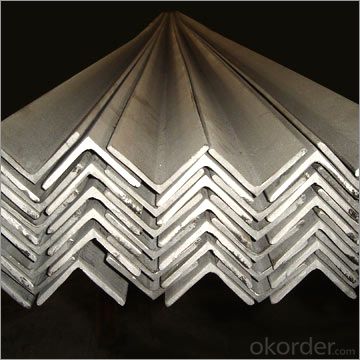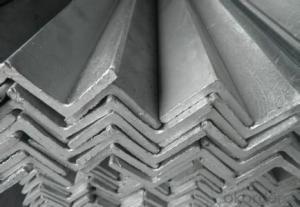Angle Steel Hot Rolled 20MM-250MM Or Unequal Angle Steel
- Loading Port:
- China Main Port
- Payment Terms:
- TT or LC
- Min Order Qty:
- -
- Supply Capability:
- -
OKorder Service Pledge
OKorder Financial Service
You Might Also Like
Product Description:
OKorder is offering high quality Angle Steel Hot Rolled 20MM-250MM Or Unequal Angle Steel at great prices with worldwide shipping. Our supplier is a world-class manufacturer of steel, with our products utilized the world over. OKorder annually supplies products to European, North American and Asian markets. We provide quotations within 24 hours of receiving an inquiry and guarantee competitive prices.
Product Applications:
According to the needs of different structures, Angle can compose to different force support component, and also can be the connections between components. It is widely used in various building structures and engineering structures such as roof beams, bridges, transmission towers, hoisting machinery and transport machinery, ships, industrial furnaces, reaction tower, container frame and warehouse etc
Product Advantages:
OKorder's Angle Steel Hot Rolled 20MM-250MM Or Unequal Angle Steel are durable, strong, and resist corrosion.
Main Product Features:
· Premium quality
· Prompt delivery & seaworthy packing (30 days after receiving deposit)
· Corrosion resistance
· Can be recycled and reused
· Mill test certification
· Professional Service
· Competitive pricing
Product Specifications:
Manufacture: Hot rolled
Grade: Q195 – 235
Certificates: ISO, SGS, BV, CIQ
Length: 6m – 12m, as per customer request
Packaging: Export packing, nude packing, bundled
Sizes: 25mm-250mm | ||||||||||||
a*t | ||||||||||||
25*2.5-4.0 | 70*6.0-9.0 | 130*9.0-15 | ||||||||||
30*2.5-6.6 | 75*6.0-9.0 | 140*10-14 | ||||||||||
36*3.0-5.0 | 80*5.0-10 | 150*10-20 | ||||||||||
38*2.3-6.0 | 90*7.0-10 | 160*10-16 | ||||||||||
40*3.0-5.0 | 100*6.0-12 | 175*12-15 | ||||||||||
45*4.0-6.0 | 110*8.0-10 | 180*12-18 | ||||||||||
50*4.0-6.0 | 120*6.0-15 | 200*14-25 | ||||||||||
60*4.0-8.0 | 125*8.0-14 | 250*25 | ||||||||||
FAQ:
Q1: How do we guarantee the quality of our products?
A1: We have established an advanced quality management system which conducts strict quality tests at every step, from raw materials to the final product. At the same time, we provide extensive follow-up service assurances as required.
Q2: What makes stainless steel stainless?
A2: Stainless steel must contain at least 10.5 % chromium. It is this element that reacts with the oxygen in the air to form a complex chrome-oxide surface layer that is invisible but strong enough to prevent further oxygen from "staining" (rusting) the surface. Higher levels of chromium and the addition of other alloying elements such as nickel and molybdenum enhance this surface layer and improve the corrosion resistance of the stainless material.
Q3: Can stainless steel rust?
A3: Stainless does not "rust" as you think of regular steel rusting with a red oxide on the surface that flakes off. If you see red rust it is probably due to some iron particles that have contaminated the surface of the stainless steel and it is these iron particles that are rusting. Look at the source of the rusting and see if you can remove it from the surface.


- Q:How do you determine the required thickness of a steel angle for a specific application?
- To determine the required thickness of a steel angle for a specific application, various factors need to be considered. These factors include the load or weight that the angle will need to support, the length of the angle, the material properties of the steel being used, and any applicable safety codes or standards. Engineering calculations and analysis are typically performed to assess the structural requirements and ensure that the selected angle thickness can withstand the anticipated forces and stresses.
- Q:Can steel angles be used in the construction of transmission towers?
- Yes, steel angles can be used in the construction of transmission towers. Steel angles are commonly used as structural components in various construction projects due to their strength, durability, and versatility. In transmission tower construction, steel angles are often used to provide support and stability. They can be used for bracing, cross arms, and other structural elements of the tower. The angles are typically made from high-strength steel to withstand the heavy loads and harsh environmental conditions that transmission towers are exposed to. Additionally, steel angles can be easily fabricated, connected, and erected, making them a cost-effective choice for transmission tower construction.
- Q:Can steel angles be used for signage or billboards?
- Yes, steel angles can be used for signage or billboards. Steel angles provide a sturdy and durable support structure for the signage or billboard, ensuring it remains stable and secure. Additionally, steel angles can be easily customized and fabricated to meet specific design requirements, making them a versatile choice for signage applications.
- Q:Are steel angles resistant to impact?
- Yes, steel angles are generally resistant to impact due to their high strength and durability. They are commonly used in construction and structural applications where impact resistance is required.
- Q:Can steel angles be used as handrails or guardrails?
- Yes, steel angles can be used as handrails or guardrails. They are commonly used in construction and provide sturdy support and protection when properly installed.
- Q:Can steel angles be used for building frames?
- Indeed, the utilization of steel angles is feasible when constructing frames. In the realm of construction, steel angles are frequently employed for framing purposes owing to their robustness and adaptability. They are commonly utilized in the formation of the structural skeleton of edifices, such as the construction of walls, floors, and roofs. Steel angles furnish stability and support to the overall structure and can be effortlessly welded or bolted together to fabricate a sturdy and enduring frame. Moreover, steel angles are obtainable in a variety of sizes and thicknesses, allowing for customization and adaptation to diverse building requisites. All in all, steel angles are a favored option for constructing frames due to their strength, versatility, and user-friendly nature.
- Q:How do you calculate the radius of gyration for a steel angle?
- The radius of gyration for a steel angle can be calculated using the formula: Radius of Gyration = √(Moment of Inertia / Area) The Moment of Inertia can be determined by considering the shape and dimensions of the steel angle. The Area is the cross-sectional area of the steel angle. By plugging in these values into the formula, the radius of gyration can be calculated.
- Q:What are the different methods of surface preparation for steel angles?
- Some of the different methods of surface preparation for steel angles include abrasive blasting, chemical cleaning, and mechanical cleaning. Abrasive blasting involves using a high-pressure stream of abrasive material to remove rust, scale, and other contaminants from the surface of the steel. Chemical cleaning involves using chemicals to dissolve and remove rust and other contaminants. Mechanical cleaning involves using tools such as wire brushes or sandpaper to physically scrape or scrub the surface of the steel to remove rust and other contaminants. These methods are important in preparing the steel surface for painting, coating, or other forms of protection against corrosion.
- Q:What are the different testing methods used for quality control of steel angles?
- There are several testing methods used for quality control of steel angles. These include visual inspection, dimensional measurements, ultrasonic testing, magnetic particle inspection, and load testing. Visual inspection involves visually examining the steel angles for any surface defects or imperfections. Dimensional measurements ensure that the angles meet the specified size and shape requirements. Ultrasonic testing uses sound waves to detect any internal flaws or discontinuities in the material. Magnetic particle inspection involves applying a magnetic field to the angles and using magnetic particles to identify any surface cracks or defects. Lastly, load testing involves subjecting the angles to a predetermined load to determine their strength and structural integrity. These testing methods help ensure that the steel angles meet the required quality standards.
- Q:Can steel angles be used in the construction of industrial chimneys?
- Yes, steel angles can be used in the construction of industrial chimneys. Steel angles provide structural support and stability to the chimney, making them a common choice in industrial construction projects.
1. Manufacturer Overview |
|
|---|---|
| Location | |
| Year Established | |
| Annual Output Value | |
| Main Markets | |
| Company Certifications | |
2. Manufacturer Certificates |
|
|---|---|
| a) Certification Name | |
| Range | |
| Reference | |
| Validity Period | |
3. Manufacturer Capability |
|
|---|---|
| a)Trade Capacity | |
| Nearest Port | |
| Export Percentage | |
| No.of Employees in Trade Department | |
| Language Spoken: | |
| b)Factory Information | |
| Factory Size: | |
| No. of Production Lines | |
| Contract Manufacturing | |
| Product Price Range | |
Send your message to us
Angle Steel Hot Rolled 20MM-250MM Or Unequal Angle Steel
- Loading Port:
- China Main Port
- Payment Terms:
- TT or LC
- Min Order Qty:
- -
- Supply Capability:
- -
OKorder Service Pledge
OKorder Financial Service
Similar products
New products
Hot products
Related keywords




























